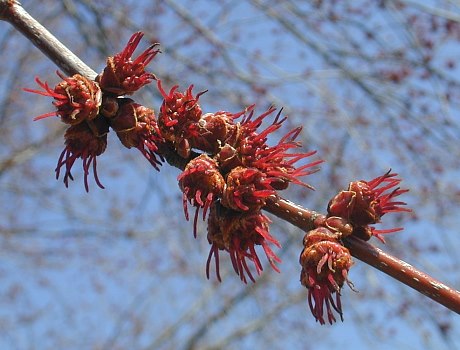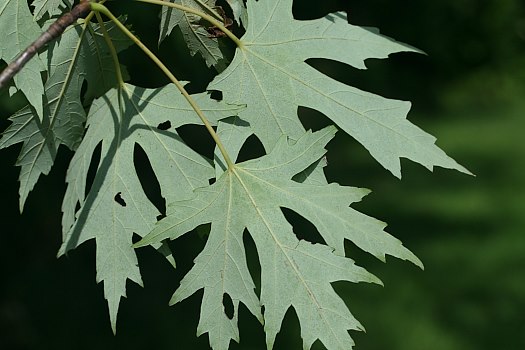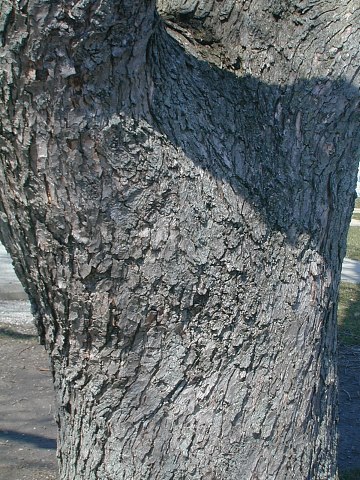Description: This tree is 60-100' tall at maturity, forming a short broad trunk and an ovoid to obovoid crown that is defined by long ascending branches of considerable size. Trunk bark of mature trees is gray and rough-textured, consisting of flattened scales and straight to curving furrows. On very old trees, the bark may become slightly shaggy when the scales become curved and somewhat loose. Trunk bark of young trees and branch bark are light gray and more smooth, while twigs are reddish brown, smooth, and covered with scattered white lenticels. Pairs of opposite deciduous leaves occur along the twigs and smaller branches. Individual leaves are up to 6" long and 4" across; they are palmately divided into 5 primary lobes. The primary lobes themselves are often divided into shallow secondary lobes and their margins have a few large teeth. All of the lobes are sharply cleft and pointed at their tips; the primary lobes extend deeply into the interior of each leaf. The upper leaf surface is light to medium-light green and glabrous, while the lower surface is conspicuously whitened and glabrous to mostly glabrous (some hairs may occur along the undersides of the major veins). The slender petioles of the leaves are up to 5" long, light green to red, and glabrous.

Individual trees of Silver Maple can be monoecious or dioecious; trees with perfect florets are rare. Some trees are capable of changing their gender from year to year. Staminate florets occur in small dense clusters about 1/3" (8 mm.) across on short lateral spur-twigs; these florets are nearly sessile and they vary in color from yellowish green to red. Individual staminate florets consist of 4 sepals, 4-6 stamens, and no petals. At the base of each staminate cluster, there are several scaly bractlets. Pistillate florets also occur in small dense clusters about 1/3" (8 mm.) across on very short peduncles; these florets are nearly sessile and they vary in color from greenish yellow to red. Individual pistillate florets consist of 4 sepals, a pistil with a pair of styles, and no petals. At the base of each pistillate cluster, there are several scaly bractlets. The blooming period occurs from early to mid-spring before the leaves develop. The florets are cross-pollinated by the wind. Fertile female florets soon develop pairs of samaras (seeds with elongated wings). In each pair, the samaras are held about 90° apart from each other (or a little less) and they are joined together at the base. At maturity, individual samaras are 1½-2½" long, becoming light brown; they dangle from slender pedicels and fall to the ground during early summer. The root system produces woody lateral roots that are fairly shallow and widely spreading. The leaves usually become pale yellow during the autumn.
Cultivation: The preference is full or partial sun, moist conditions, and soil containing silt-loam, loam, or clay-loam. Temporary flooding is readily tolerated. This tree can also adapt to drier conditions. Because the wood of this fast-growing tree is relatively brittle and weak, it is vulnerable to both wind- and ice-damage. Furthermore, its widely spreading roots can uplift and damage sidewalks, and they can invade sewer and water lines. The seeds (with their membranous wings) can be planted in the ground as soon as they become available because they germinate almost immediately without any pre-treatment. If they are allowed to dry out, the seeds will lose their viability.

Range & Habitat: In Illinois, the native Silver Maple is a common tree that is found in every county (see Distribution Map). Habitats consist primarily of moist floodplain woodlands, riverbanks, and swamps. In these types of habitats, Silver Maple is often one of the codominant trees. In drier locations, it is not competitive with Sugar Maple (Acer saccharum) and other trees in the long run because its seedlings are less tolerant of shade. This tree is often cultivated as a landscape plant in yards and parks. In urban and suburban areas, the offspring of these cultivated trees often escape into adjacent areas that are not mowed (e.g., fence rows and vacant lots).
Faunal Associations: While honeybees occasionally gather pollen from the staminate florets, they are not effective pollinators because the nectarless pistillate florets are not visited. The leaves, wood, and other parts of Silver Maple and other maples (Acer spp.) are sources of food to many insects, including the wood-boring larvae of several long-horned beetles (see Long-horned Beetle Table). Such insects as the larvae of metallic wood-boring beetles, larvae of moths, aphids, armored scale insects, mealybugs, and plant bugs have been observed to feed on Silver Maple specifically (see Insect Table). Some species of birds eat the seeds or buds of these trees (see Bird Table). The seeds in the samaras are also eaten by many mammals, including the Black Bear, Raccoon, Gray Squirrel, Fox Squirrel, Eastern Chipmunk, Cottontail Rabbit, White-Footed Mouse, and Meadow Vole. Tree squirrels also eat the buds of Silver Maple during late winter to early spring when other sources of food are scarce. Silver Maple is an important source of food and construction material for the American Beaver, while the foliage and twigs are eaten by the White-Tailed Deer. Because aging trees of Silver Maple often form cavities in their trunks and larger branches, they provide nesting habitat for such birds as the Screech Owl and Wood Duck, and dens for tree squirrels, raccoons, and opossums.

Photographic Location: Chief Shemauger Park and Meadowbrook Park in Urbana, Illinois.
Comments: Because of its rapid growth and attractive foliage, Silver Maple is a popular and commonly encountered tree in both urban and suburban landscapes. It is readily distinguished from other maples (Acer spp.) by its deeply lobed leaves with whitened undersides. Silver Maple is closely related to Acer rubrum (Red Maple), preferring similar habitats. Because their clustered florets bloom early in the spring, they sometimes hybridize, forming Acer × freemanii (Freeman's Maple). The leaves of Freeman's Maple resemble those of Silver Maple, except the sinuses of their lobes are a little more narrow and shallow, and their petioles are bright red. This hybrid maple is more common in cultivation than in the wild; it is largely sterile.